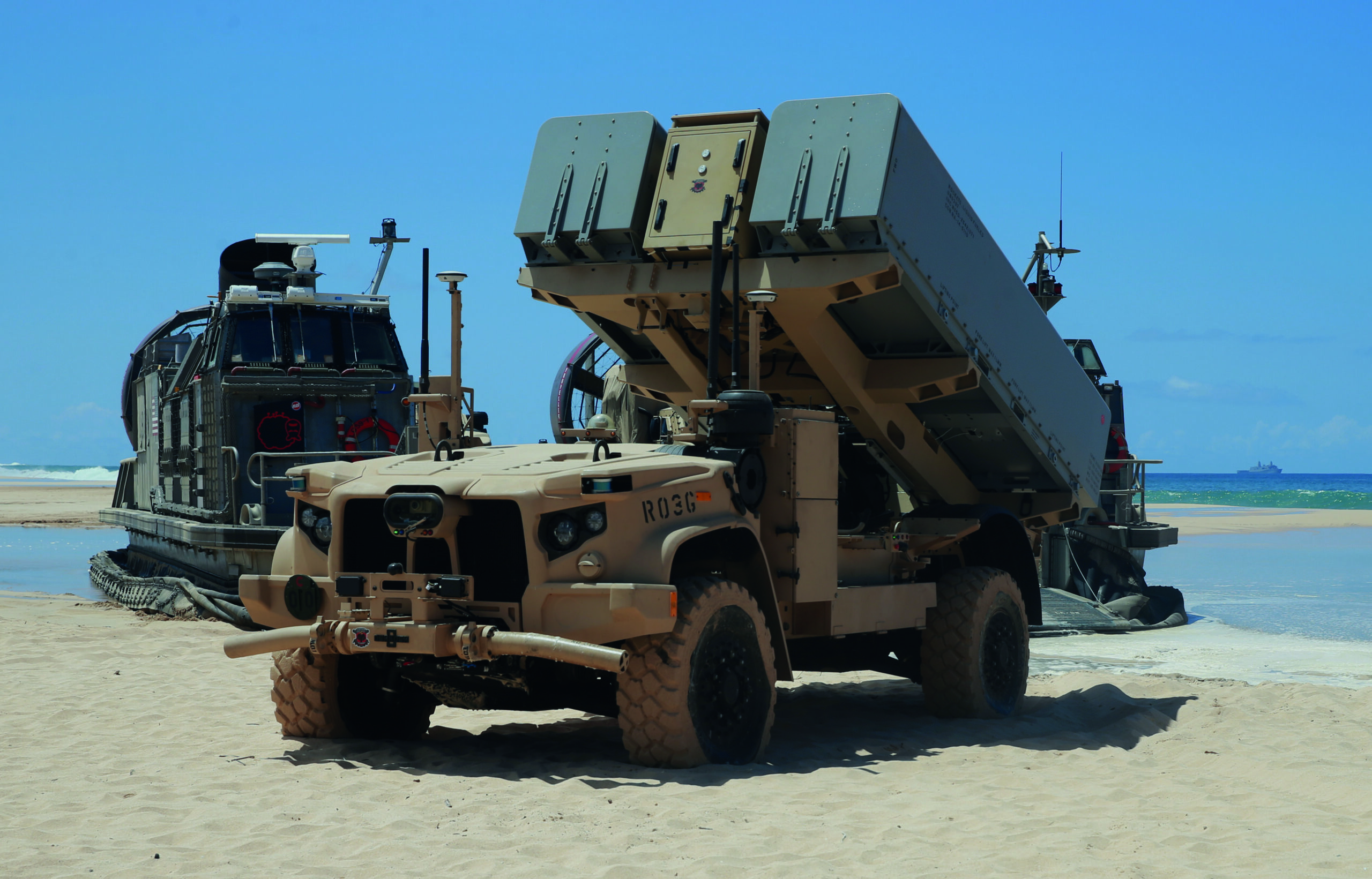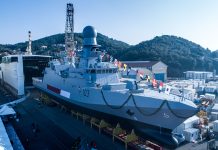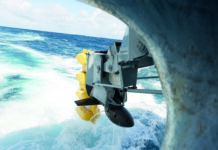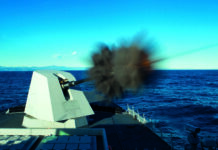As seen with the recent anti-ship operations in Russia’s war against Ukraine, the latter’s forces attacked the Russian Black Sea Fleet’s flagship, the missile cruiser MOSKVA and also a re-supply ship with land-based anti-ship missiles, resulting in the sinking of both ships in two different events. Related to the attacks, a comment made by the US Chief of Naval Operations Admiral Mike Gilday, who underscored the need for the US Navy to put more resources into fleet defence, when asked about new developments the service is pursuing as a result of the more dangerous security environment.
In his comments, Gilday highlighted the importance of the threat posed by Mobile Coastal Defence Systems (MCDS) equipped with anti-ship missiles as a capable ground-based anti-access/area denial, anti-ship capability. The latter are easy to be deployed and difficult to be detected. They are located according to their mobility and when available, have stand-alone surveillance and targeting capabilities, if not integrated into the national or theatre of operations’ surveillance and targeting network.
HARPOON
While continuing to pursue campaign opportunities for the latest versions of its family of shipborne and air-launched HARPOON weapon systems, after the US State Department’s approval of the possible foreign military sale in October 2020, Taiwan became a new customer of a Coastal Defence System based on the Boeing missile system. After an initial US$220M non-recurring engineering contract awarded in September 2021, the US Naval Air Systems Command awarded Boeing a US$498,3M order in March 2022 for the production and delivery of the HARPOON Coastal Defense Launch System (HCDS) in support of the Government of Taiwan.
Running through December 2028, the contract includes the supply of 100 launcher transport units, 25 radar units and HCDS training equipment. In the previous determination to approval statements, the request was for delivery of up to 400 RGM-84L-4 HARPOON Block II surface-launched missiles and four RTM-84L-4 HARPOON Block II exercise missiles. This is in addition to 411 containers and the same number of launcher transport units, 25 radar trucks, spare and repair parts, support, and test equipment, alongside personnel training and equipment, technical assistance, and logistics support services. The total estimated programme cost was valued US$2.37Bn. Taiwan is the latest customer of a HCDS after the Danish MoD retired two coastal mobile batteries of the Boeing missile in the 2000s (Denmark used the system on board its ships). Although no details were provided about the used HARPOON version, Denmark was the first international customer of the Block II version upgrade kits, which were installed by the Danish Naval Materiel Command on about half of in-service HARPOONs with deliveries of upgraded missiles from April 2002.
The initial HARPOON Block IC (HIC) version, with an approximate range of 120 km, entered service in 1977 with the US Navy together with the Block II version (AGM/RGM/UGM-84L) in 1998, which then saw wide international success, but was not acquired by the US DoD, which instead procured the air-launched Block II + model. Incorporating the low-cost Inertial Measuring Unit (IMU) from the Boeing Joint Direct Attack Munition (JDAM) programme and the software, mission computer, integrated Global Positioning System/Inertial Navigation System (INS/GPS), GPS antenna and receiver from the Standoff Land Attack Missile Expanded Response (SLAM ER), the BLOCK II provides both anti-ship and land attack capability, maintaining compatibility with in-service launching systems.
With the Russian invasion of Ukraine and following naval operations causing the sinking of the MOSKVA by locally-made NEPTUNE anti-ship missiles, the Ukraine MoD acknowledged in May the delivery of an undisclosed number of HARPOON-based Coastal Defence System launchers and munitions from NATO members. They also announced the successful combat use of these weapons against a Russian Navy re-supply tugboat, which was confirmed by US officials in a Pentagon background briefing. On 15 June, after the US DoD announced new security assistance funding for Ukraine’s near-term defence capabilities, including two HARPOON coastal defence systems in a Pentagon background briefing on the same day, senior officials told reporters that the US will provide a new launch capability. This will be able to be truck-mounted with a contracting action in the next couple of months and will be married up with missile capabilities provided by allies and partners.
NSM and TOMAHAWK
As the US Marine Corps’ first Ground Based Anti-Ship Missile (GBASM) capability, the Navy/Marine Corps Expeditionary Ship Interdiction System (NMESIS) will be employed by the Medium-range Missile (MMSL) batteries serving as part of the Marine Littoral Regiments (MLR) conducting Expeditionary Advanced Base Operations (EABO). Providing a ground-based anti-access/area denial, anti-ship capability, the NMESIS consists of two Naval Strike Missile (NSM) provided by Raytheon as prime contractor, together with Kongsberg Defence & Aerospace (KDA).
It also consists of a launcher/weapon control system integrated on to a ground-based, teleoperated carrier called ROGUE-ROGUE Fires carrier, weapon control system (WCS), and Command and Control (C2) connections, to enable the transport and firing of NSMs. The NMESIS makes extensive use of proven sub-systems, such as the Joint Light Tactical Vehicle (JLTV) chassis, the US Navy’s Naval Strike Missile and its WCS. Developed by KDA to meet the Royal Norwegian Navy’s requirements, the NSM entered service with the latter in 2012 and was selected and procured by the US Navy in 2018, being designated NSM Block 1 (US designation RGM-184A). With a low-observable composite-made 3.96-metre-long airframe, equipped with a turbojet engine and fuel tank enabling an operational range in excess of 200 km, weighing approximately 400 kg, the NSM features a 227 kg insensitive munition warhead and an advanced passive guidance package that combines GPS-aided multi-sensor navigation with an advanced dual-band imaging infrared (IIR) seeker with ATR and seeker-generated aim point for terminal guidance, in addition to programmable endgame manoeuvres.
On 22 December 2021, Raytheon’s Missiles and Defense was contracted by the US Marine Corps Systems Command to provide production representative models of the NMESIS, which will conduct ballistic and guided flight tests in Q3 FY 2023. The system entered service in a CDS initially with Poland and was then ordered in 2021 by Romania. It comes in a baseline core configuration, which includes the Kongsberg Fire Distribution Centre (FDC) providing Battle Management Command Control Communication Computers and Information (BMC4I), in addition to an NSM launcher fire unit with four missiles and radar sensor module, customer selectable in terms of vehicles, number of launchers and sensors suite. More recently, based on the Australian Army’s future Land 4100 Phase 2 deployable land-based anti-ship weapon requirement, Kongsberg Defence Australia and Thales Australia joined forces to develop the STRIKEMASTER solution. This marries Thales Australia’s BUSHMASTER 4×4 flatbed utility vehicle and a twin-pack launcher for the KDA Block 1A NSM latest variant. Selected by Canada, in addition to Norway, Poland, Germany, Malaysia, and the US, KDA announced last July the NSM procurement by Australia for shipborne operations. Under a joint acquisition programme announced in July 2021, Norway and Germany are developing the NSM Block 1A, which forms the basis of the upgrade of the in-service Norwegian munitions inventory, plus new missiles under a contract awarded to KDA in October 2021, while Germany will acquire new munitions. According to KDA, the Block 1A model (US designation RGM-184B), is a modified version of NSM Block 1 (RGM-184A), including a number of technology updates, new engine and various performance improvements, such as extended range. The NSM also comes in an air-launched version with modified airframe called Joint Strike Missile (JSM) for the F-35 internal transportation acquired by Norway, Japan and Finland.
In addition to the NMESIS, MMSL batteries serving as part of the Marine Littoral Regiments (MLR), the future base unit of the US Marine Corps, will also be equipped with longer-range munitions, such as the TOMAHAWK Land Attack Munitions, Maritime Strike TOMAHAWKs and SM-6 containerised anti-ship missile, according to the USMC Commandant statement delivered in 2021 to the Senate Armed Services Committee.
In May 2022, the US Naval Air Systems Command awarded Raytheon a US$217.1M contract for 154 full-rate production BLOCK V Tactical TOMAHAWK All Up Round Vertical Launch system missiles, including for the first time 54 for the Marine Corps and 30 for the Army. The Marine Corps, according to the same NAVAIR press statement, is developing and fielding a ground-based TOMAHAWK launcher, without providing additional details. Scheduled to be delivered by 2025, the full-rate production Lot 18 missiles will be in the Block V configuration, which features a NAV/COMMS upgrade that maintains the capability for in-flight updates and improved navigation.
According to the NAVAIR press statement, the future Block V capabilities will include the Maritime Strike TOMAHAWK (MST) variant and the Joint Multiple Effects Warhead System (JMEWS). The MST variant (designated as Block Va), according to US Navy documentation, will add a new suite to provide midcourse and terminal guidance based on third party and a new multimode seeker to prosecute maritime targets. The NAVAIR TOMAHAWK Weapon System Program Office (PMA-280) is working closely with the US Army’s Rapid Capabilities and Critical Technologies Office (RCCTO), based on the PMA-280 ongoing modernisation effort, investment strategies and joint test events for the Army’s Mid-Range Capability programme, a system that is on track to be delivered to its first unit in FY 23. No further details were provided, but the US Army battery level MRC prototype with on tractor-trailers’ mounted four-cell VLS launchers (four in total) based on the US Navy’s Mk 41 design, is expected to form the basis for the land-based solution.
New MCDS and EXOCET, MARTE ER, TESEO Mk 2/E
By the end of 2021, MBDA delivered the components of the first new generation anti-ship mobile coastal defence system (MCDS) to its launch customer represented by the Qatar Emiri Naval Forces (QENF). Under an undisclosed value contract awarded in September 2016, and the long experience accumulated with in-service CDSs launching the same company’s EXOCET MM 40s and OTOMAT/TESEO Mk 2 Block IV, alongside proven MARTE Mk 2/N, MBDA is delivering an unrevealed number of MCDSs. In its basic configuration, an MCDS comprises a mobile sensor unit (MSU) with both surface search radar and EO/IR sensors on telescopic mounts, a mobile control unit (MCU) with a non-disclosed number of operator consoles and a flexible number (up to four) of mobile firings units (FUs), each equipped with four missiles, together with mobile maintenance and reloading units as required. Each FU has been developed to accommodate the weapon firing and mission electronics containerised module and the inclined ramp on a single platform. The latter can house either up to four EXOCET MM 40 Block 3 missiles or alternatively the same number of MARTE ER missiles, allowing the same vehicle and launcher platform together with the same sensors and control units to be used for different weapon systems. The MCU is networked by design and can be interfaced with over-the-horizon surveillance and targeting platforms, as specified by the customer. The CDSs are continuing to be delivered in 2022 to the QNEF alongside both the EXOCET Block 3 and the MARTE ER munitions and are offered on the international market. The MBDA MCDS can also accommodate the under development TESEO Mk 2E long-range anti-ship, land-attack missile, further expanding the potential customer base.
The MBDA group and the French MoD further developed the family of ship, air, land and underwater-launched EXOCET missiles to cope with current and future operational scenarios and threats. The latest upgrade is the MM40 Block 3c version due to be delivered to the French Navy later this year in the form of new missiles and an upgrade of in-service munitions, with Greece as the first international customer to equip the new Defence and Intervention Frigates (FDI HN). The Block 3c version, where the ‘c’ stands for ‘coherent’, introduces a new digitised package centred on a new coherent active RF seeker developed by Thales, together with a digital radar altimeter and a new GPS receiver, alongside an internal Ethernet bus. Coherent radar introduces significant improvements in target sensitivity (low signature targets) and electronic counter-countermeasures (ECCM) performance. In addition to the French Navy, the MM 40 Block 3 (which entered service in late 2010), equips or has been ordered by more than ten customers. Characterised by a less than 6-metre-long airframe (with booster) and weighing 780 kg, the Block 3 version features a powerful SAFRAN TR40 turbojet. This provides an extended operational range of around 200 km and a guidance suite, including an active non-coherent RF seeker and an advanced hybrid INS/GPS navigation package, alongside a new launch and mission planning infrastructure.
MBDA completed development and qualification firing of the MARTE Extended Range (ER) in November 2021, opening the way to deliveries and entering into operation to the Qatari MoD launch customer to equip the new MCDS in 2022 alongside a helicopter-launched variant for the under-delivery NHIndustries NFH90 naval helicopters by Leonardo. A latest generation, extended range variant of the MARTE anti-ship missile family, the ER model has been conceived as a multi-platform munition capable to be launched by coastal mobile/naval, rotary-wing/slow speed fixed wing and fast jet platforms. The MARTE ER weighs approximately 300 kg (<345 kg with boosters), is 3.6 m long and has a 316 mm large fire-and-forget weapon system equipped with a new turbojet. This is based on the WJ-24-8G engine supplied by Williams International, which delivers a high-subsonic munition with an effective range of ‘well beyond’ 100 km. Equipped with a 70+ kg semi-armour piercing HE insensitive warhead and a navigation and guidance suite centred on an INS/GPS and a new solid state RF Seeker developed and produced by MBDA Italia, the MARTE ER maintains the same launch control system and canister technology of the MARTE Mk2/N model. As a multi-platform munition, the MARTE ER munition comes also in a fast-jet variant, the latter being initially proposed to be implemented on the Eurofighter TYPHOON platform.
Based on its long experience with TESEO and MARTE families of weapon systems, MBDA is now developing for the Italian MoD a completely new long-range missile weapon system called TESEO Mk 2/E, featuring an innovative dual mode head section including a new generation Active Electronically Scanned Array (AESA) RF seeker, capable of long anti-surface and deep land-attack operations. The new missile is expected to complete qualification and industrialisation phases by end-2026/beginning-2027. The Mk2/E version has a 4.77-metre-ong transonic and stealthy shaped airframe to reduce overall signature. The airframe features enhanced aerodynamics and flight controls and a new propulsion system centred on a Williams International turbofan with a fuel-tank and anti-g system package, alongside a single coaxial booster. This is designed to facilitate a future potential deployment from vertical launching systems. The Mk2/E version will also have a high subsonic cruise speed and high-G terminal manoeuvrability with an effective range of 350 km at sea-skimming level. Weighing circa 700 kg ‘in the cruise phase’, plus the booster weight and a new single-shot lightweight canister, the Mk2/E will feature a state-of-the-art navigation suite. This will include a new two-way SATCOM data link system, focusing on target update, reassignment and mission abort and an innovative terminal guidance based on a dual mode head section including an RF seeker and an E/O sensor. The TESEO Mk2/E will be the first European ASCM equipped with a new generation active-electronically scanned array (AESA)-based RF seeker jointly developed by MBDA as prime, together with Leonardo, alongside a semi-active laser (SAL) channel for surgical attacks, in addition to a scalable insensitive warhead and an advanced mission planning system.
The RBS 15 Family
In February 2022, the Swedish Ministry of Defence announced that their National Armed Forces have increased their presence on the country’s southern coast, including Gotland Island, as well as at sea. In addition to a higher-than-usual operational tempo at sea, the Swedish Armed Forces also deployed coastal defence systems based on the Saab RBS 15 anti-ship missiles in the nation’s southern region. This capability was re-introduced into the Swedish Armed Forces in 2016, with part of the equipment coming from a former coastal mobile battery, but much has been modernised and adapted to current requirements. In addition to Sweden, coastal defence systems based on the RBS 15 family of missiles were procured and are in service with Finland and Croatia in different battery and vehicle configurations. The same weapon system, in different models, has been procured and is in service with the navies of Sweden, Algeria, Croatia, Finland, Germany, Poland and air forces of Sweden and Thailand. Jointly produced and marketed by Saab and Diehl Defence, the latest in-service RBS15 Mk 3 version is 4.35 m in length, has a 0.50 m fuselage diameter, and weighs (in flight) about 660 kg. It has a range of over 200 km, possesses all-weather and fire-and-forget capabilities, providing stand-off attack with flexible trajectory characterised by multiple 3D waypoints. Furthermore, it is equipped with an advanced navigation suite with INS/GPS, together with a terminal guidance based on an active radar seeker with built-in electronic counter-countermeasures (ECCM) and a lethal (roughly 200 kg) blast and fragmentation warhead triggered by delayed impact or proximity fuse function, allowing not only the successful engagement of vessels, but also shore-based targets. The Swedish Defence procurement agency contracted Saab in 2017 for the development and initial production of a fourth generation version of the RBS 15 to equip the Navy’s VISBY class corvettes and Air Force JAS-39 GRIPEN E multi-role fighters to be delivered in the mid-2020s. Branded GUNGNIR (Odin’s Spear) by Saab at system level for the different versions, the new RBS 15 Mk 4 is externally similar to current versions but will use a new composite launching box canister (different from the current hexagonal shaped canister) to simplify integration on naval platforms. It has been redesigned and re-architectured internally, introducing technology enhancements in the airframe, navigation suite, on-board processing, and active radar seeker to improve the all-weather capabilities, survivability and develop a significant range enhancement. The new version will have a range of more than 300 km in a sea-skimming surface-to-surface flight profile, while upgrades have been applied mainly to the Saab-developed multi-purpose computer, navigation suite with an anti-jam GPS and an expanded terminal phase manoeuvring envelope alongside a new active radar seeker, which incorporates significantly improved ECCM functionalities, alongside growth capabilities including data-link.
BLUE SPEAR
In October 2021, the Estonian Centre of Defence Investment (ECDI) awarded a contract to the Proteus Advanced Systems joint venture between Israel Aerospace Industries (IAI) and ST Engineering for developing Estonian coastal defence capabilities centred on the BLUE SPEAR fifth generation surface-to-surface missile (5G SSM). According to Proteus Advanced Systems, the advanced and versatile missile can perform a variety of long-range precision strike options in congested scenarios, against both ship and land targets in all-weather conditions. The BLUE SPEAR is one of the most recent developments and bespoke derivatives of the latest IAI Gabriel family technology. It first saw international success in July 2018 when the Finnish MoD contracted IAI to provide a new-generation anti-ship missile to be installed on the Navy’s new POHJANMAA class corvettes, upgraded HAMINA class missile fast attack craft and a vehicle platform, indirectly referring to a coastal defence system. No details have been provided on the weapon’s dimensions and weight by the joint venture’s two mother companies, but the BLUE SPEAR airframe and flight controls are very similar to those of the missile images shown by the Finnish MoD/Navy, the latter referring to a 1,250 kg and 5.5-m-long subsonic airframe. The BLUE SPEAR also bears similarities with the SEA SERPENT SSM, which has been proposed to satisfy the requirements of the UK MoD for an Interim Surface-to-Surface Guided procurement programme. The SEA SERPENT “has been developed in parallel with similar missile systems in service with the Israeli Navy and selected to provide powerful strike capabilities for Finland’s SSM2020 programme”, said IAI, presenting the customised solution. Capable of operating in all weather conditions, both day and night, the BLUE SPEAR features a ‘jet propelled engine’ allowing the missile to achieve high-subsonic speeds and a maximum range of 290 km. The new missile features accurate INS-based navigation capabilities and a robust system, which is immune to GPS disruptions offering “maximal accuracy target acquisition”. The system is equipped “with a variety of deception means to achieve its mission and cope with the different battlefield challenges”. Thanks to a state-of-the-art radar seeker, an advanced weapon control system, together with a fully automated mission planning and execution, exploiting multiple way points and complex trajectories to achieve the maximum penetration of layered and point defences, the missile has beyond line of sight strike capabilities against both mobile and stationary targets. It has a 150 kg high explosive insensitive munition warhead, and is also equipped with an advanced data link, to prevail in contested, congested and complex situations.
ATMACA
In July 2022, the Turkish Ministry of Defence and Rocketsan announced the successful test firing of the new coastal variant of the locally developed ATMACA (Hawk) anti-ship missile. The first ever test of the land-based version of the missile was conducted against a sea target in the Black Sea on 2 July from a truck-mounted four-missile launcher. Unlike the ship-based version, the missile was equipped with an imaging infrared seeker (IIR) as disclosed by the video footage of the live firing. In March, Roketsan announced it was working on a coastal defence system, developed around the ATMACA anti-ship missile, but equipped with an IIR seeker, without providing further details on the new version. Delivered to the Turkish Navy from last December, the ATMACA anti-ship missile was developed as a long-range, surface-to-surface, precision-strike anti-ship missile, capable to be integrated into assault boats, frigates, and corvettes. It is 5.2 m in length with the booster (4.3 m in flight) weapon system, and equipped with a turbojet engine providing an over 220 km declared range. Weighing less than 750 kg at launch, it features an autonomous INS/GPS guidance suite, a barometric and radar altimeter to give it sea-skimming capabilities. In the final attack phase, the system activates its RF seeker while a data link ensures target update if needed, as well as re-attack or mission abort. It features a 220 kg high explosive-fragmentation warhead ensuring effective penetration against naval and land targets. An advanced 3-D mission planning allows time-on-target, designated time-on-target, simultaneous time-on-target, and salvo modes.












